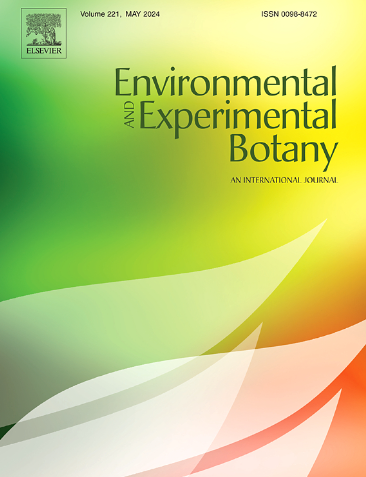蛋白质组学分析揭示了高海拔马尔贝克浆果和叶片的UV-B驯化途径
IF 4.7
2区 生物学
Q2 ENVIRONMENTAL SCIENCES
引用次数: 0
摘要
高海拔葡萄种植(Vitis vinifera L.)为气候变化下生产优质葡萄酒提供了可持续的策略。然而,在田间种植的葡萄中,UV-B驯化的分子机制尚不清楚。本研究在阿根廷门多萨的一个高海拔葡萄园(1350 m a.s.l.)研究了不同UV-B暴露(排除与完全暴露)对马尔贝克葡萄不同发育阶段叶片和浆果的影响。定量蛋白质组学揭示了对UV-B的组织和阶段特异性反应,其中叶片在变异时反应最灵敏。只有两种蛋白——omega-羟铝酸酯o -阿铁酰转移酶和查尔酮异构酶——在所有组织和阶段都持续上调。对其启动子的计算机分析表明,光、激素和应激信号对其进行调控。UV-B改变了初级和次级代谢。光合作用相关蛋白在变熟后的叶片中减少,而在变熟前的果皮中增加。在浆果的整个发育过程中,与压力相关的蛋白质表现出相反的趋势。在+UV-B处理下,多酚的生物合成和抗氧化能力增强,转酮醇酶、3-脱氧-d -阿拉伯-庚糖酸7-磷酸合成酶(DHS)和查尔酮异构酶是多酚积累的关键因素。UV-B诱导叶片木质素和类黄酮的生物合成,促进浆果皮花青素的生物合成,有利于类黄酮3’,5’-羟化酶(F3’5’h)分支。UVR8异构体的丰富度与花青素相关反应相关,而咖啡酰辅酶a o -甲基转移酶-2异构体可能介导UV-B胁迫下飞鸽苷的甲基化。随着浆果成熟,抗氧化防御机制从非酶机制转变为酶机制。这是对高海拔、田间种植的葡萄浆果进行的第一次蛋白质组学研究,为研究UV-B驯化及其在气候变化中提高葡萄和葡萄酒质量的潜力提供了新的见解。本文章由计算机程序翻译,如有差异,请以英文原文为准。
Proteomic analysis reveals UV-B acclimation pathways in high-altitude Malbec berries and leaves
High-altitude grapevine cultivation (Vitis vinifera L.) offers a sustainable strategy for producing premium wines under climate change. However, the molecular mechanisms of UV-B acclimation in field-grown grapes remain unclear. This study examined the effects of contrasting UV-B exposure (exclusion vs. full exposure) on Malbec grape leaves and berries at different developmental stages in a high-altitude vineyard in Mendoza, Argentina (1350 m a.s.l.). Quantitative proteomics revealed tissue- and stage-specific responses to UV-B, with leaves at veraison being the most responsive. Only two proteins—omega-hydroxypalmitate O-feruloyl transferase and chalcone isomerase—were consistently upregulated across all tissues and stages. In silico analysis of their promoters suggested regulation by light, hormones, and stress signals. UV-B altered both primary and secondary metabolism. Photosynthesis-related proteins were reduced in veraison leaves but increased in pre-veraison berry skins. Stress-related proteins showed opposite trends across development in berries. Polyphenol biosynthesis and antioxidant capacity were enhanced in +UV-B treatment, with transketolase, 3-deoxy-D-arabino-heptulosonate 7-phosphate synthase (DHS), and chalcone isomerase emerging as key contributors to polyphenol accumulation. At veraison, UV-B induced lignin and flavonoid biosynthesis in leaves and promoted anthocyanin biosynthesis in berry skins, favoring the flavonoid 3′,5′-hydroxylase (F3′5′H) branch. UVR8 isoforms abundance correlated with anthocyanin-related responses, and a caffeoyl-CoA O-methyltransferase-2 isoform may mediate delphinidin methylation under UV-B stress. As berries matured, antioxidant defenses shifted from non-enzymatic to enzymatic mechanisms. This first proteomic study of high-altitude, field-grown grape berries provides new insights into UV-B acclimation and its potential to enhance grape and wine quality in a changing climate.
求助全文
通过发布文献求助,成功后即可免费获取论文全文。
去求助
来源期刊

Environmental and Experimental Botany
环境科学-环境科学
CiteScore
9.30
自引率
5.30%
发文量
342
审稿时长
26 days
期刊介绍:
Environmental and Experimental Botany (EEB) publishes research papers on the physical, chemical, biological, molecular mechanisms and processes involved in the responses of plants to their environment.
In addition to research papers, the journal includes review articles. Submission is in agreement with the Editors-in-Chief.
The Journal also publishes special issues which are built by invited guest editors and are related to the main themes of EEB.
The areas covered by the Journal include:
(1) Responses of plants to heavy metals and pollutants
(2) Plant/water interactions (salinity, drought, flooding)
(3) Responses of plants to radiations ranging from UV-B to infrared
(4) Plant/atmosphere relations (ozone, CO2 , temperature)
(5) Global change impacts on plant ecophysiology
(6) Biotic interactions involving environmental factors.
 求助内容:
求助内容: 应助结果提醒方式:
应助结果提醒方式:


